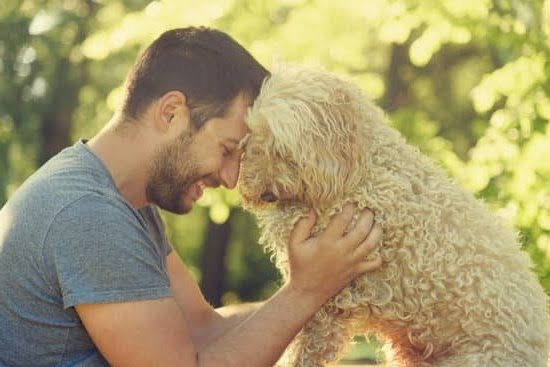Introduction
Resource guarding is a common issue faced by dog owners where a dog displays signs of aggression in order to protect an item of value, such as food, toys or humans. This problem arises when the dog perceives these belongings as his or her own and will use aggression in order to guard them from others. The severity at which this problem manifests can vary – some dogs might simply show a slight exaggeration in submissive behavior while more serious cases present more intense aggressive reactions.
Resource guarding is often rooted in fear and uncertainty, exacerbated by poor socialization skills, inadequate supervision and lack of proper training around strangers and when interacting with other dogs. Other potential causes could include exposure to situations where resources are scarce or the tension created by the introduction of a new pet into the home. In some cases, the behavior manifests even though there do not seem to be any obvious triggers that might have caused it. Ultimately, it is important for pet owners to understand that resource guarding stems from a variety of causes in order for them to properly address this issue and find an optimal treatment plan for their pet.
Identifying and Addressing Signs of Resource Guarding
Resource guarding is a normal behavior in canines but can become troublesome if it is not managed correctly. Resource guarding occurs when a dog becomes possessive of an item (or person) and will display signs to protect that which they deem as theirs. Signs of resource guarding include growling, snapping and biting if challenged or moved away from the item, raising the hackles/fur on their neck/spine, showing teeth and a stare.
To properly address resource guarding, it is important to identify when these behaviors are happening. Be observant for manners, such as lip licking, tense body frames and avoidance behaviors. Additionally, observe how often the behavior occurs during playtime with other pets or people. Pay attention to the intensity of the behavior and whether it escalates quickly or modulates over time with continued exposure to a particular person or pet.
Once you’ve identified moments when your pet may be displaying signs of resource guarding, start working on desensitizing them to be around said item or person without being agitated. To do this successfully, reward your pet with treats whenever they are in presence of said items or persons without exhibiting any signs of aggression or possessiveness. As they become more comfortable around these items or persons without displaying any signs of aggression then use positive reinforcement methods such as clicker training and verbal praise when their behavior remains non-aggressive in nature even if there may times where their guard raises due to instinctual responses by providing them with treats so that they begin associating people’s entry into the guarded space positively instead of defensively. Ensure that the approach done is slow and gradual in order for your dog not to associate any negative behaviours with anyone entering his space once defended upon being given no choice about it at all.
Establishing Rules for Resource Guarding in Dogs
Resource guarding is a phenomenon in which a dog growls or snaps when it feels that its resources, such as food or treats, are threatened. It’s important to establish rules and boundaries when dealing with dogs who are resource guarding so they understand appropriate behavior when someone comes close to their possessions.
When training your pup to not guard his resources, it’s important to start by setting clear boundaries that he must adhere to. Teach him that different people shouldn’t touch his bowl or toy unless given permission from you. Encourage visitors, family members and friends to ignore your pup’s food until the dog is both calm and non-reactive. If anyone attempts to touch the object, immediately tell them no and reward your dog for not showing aggression. Additionally, practice dropping food from your hand into the dog’s bowl while praising him gently for being non-reactive, letting him know that people will sometimes come near his bowl with food but nothing bad will happen as long taking things slow and steady is key
You should also practice approaching each resource slowly over multiple sessions and rewarding your pet for not guarding it. Gradually increase the distance between yourself and the object as long as he remains relaxed then slowly move toward it while continuing this positive reinforcement. Different distractions can be added as well such as tossing treats away or giving verbal commands like “sit” or “lay down” if he gets anxious; anything you can do is helpful in teaching obedience in addition to proper manners around resources. Finally, always make sure there is something else available for the dog such as toys or chew bones during training so they have a backup item if they begin to show signs of anxiety or guarding behavior towards a specific resource during training sessions.
De-escalation Techniques for Disruptive Resource Guarding
Resource guarding can be a disruptive issue in dog training. While this type of guarding is typically a defensive reaction that the dog has due to stress or fear, it can still disrupt well-meaning training activities and negatively impact the relationship between the handler and the dog. Dog owners should know how to quickly de-escalate an encroaching resource guarding situation in order to keep their dogs safe and well-behaved.
The best way to begin de-escalation of a resource guarding situation is by avoiding it altogether. If a handler knows their dog is prone to resource guarding, they should take steps ahead of time to prevent any potential problems. This can be done by keeping training areas free of food items and objects like toys which may cause contention between two animals. Additionally, teaching dogs appropriate greetings with unfamiliar people or animals may reduce the chances of resource guarding in those situations as well.
When avoidance isn’t possible and a resource guarding situation does occur, handlers should know how to diffuse it quickly without further escalating stress levels in either the animal or themselves. To do so, it is important to acknowledge what emotions out dog may be experiencing while remaining calm themselves. As we best possible validate our pet’s feelings rather than deny them outright (e.g., saying “I see you’re feeling nervous right now”), we become better equipped to move on and find ways to sooth anxiety or quell aggression. When done within reason, using positive reinforcement while providing calming petting can help strengthen behavior patterns that who help our pets win over whatever triggers concern in challenging scenarios like resource Guarding .
Training Exercises to Overcome Resource Guarding Issues
Resource guarding is a common issue among dogs, where they display possessiveness, aggression, or other defensive behaviors when approached near a particular item. To help your dog overcome these issues in a healthy and affirmative way, it’s important to practice specific exercises designed to give your pet the confidence he needs to remain calm around his prized possessions.
One of the most effective exercises for teaching your dog proper resource guarding habits involves trading toys or treats with him. You will want to start by pushing the boundaries of his comfort zone with this activity by placing yourself closer and closer each time you approach him while he has his favorite toy or treat. Only reward him when he stays calm and allows you to take the item away without being aggressive. This exercise will then reinforce positive behavior in your pet and allow him to trust that he won’t lose his prized possessions if someone else gets close.
In addition, you can use positive reinforcement with your dog by offering high-value treats such as pieces of meat or small bits of cheese when in close proximity to his resources. This tactic lets your pup know that not only does trading with people equate to receiving something amazing, but it also serves as an invaluable reminder that some good comes from allowing those approaching him having access to his treasures. Additionally, you may want to consider using food puzzles and other interactive feeders which encourage positive behaviors while decreasing resource guarding tendencies.
Recommended Resources and Equipment for Resource Guarding
Resource guarding is a common behavior in dogs and can be an indication of insecurity or fear. It can also be due to learned behavior from having a history of punishment associated with valued resources. Properly training your dog to not guard objects is important for their safety and for the safety of anyone around them.
In order to successfully train your dog on resource guarding, there are some recommended resources and equipment that can help make the process more successful.
Treats: High-value treats like liver, chicken, cheese, peanut butter and hot dogs are great motivators during positive reinforcement dog training. These treats should only be used when your dog has stopped displaying any signs of resource guarding and never as punishment.
Chew toys: Chew toys are another great tool for distracting your dog away from objects they may be guarding or preventing them from even thinking about it in the first place. Chew toys come in a variety of shapes and textures that your pup may find fun and exciting which will help build their confidence while playing with them instead of guarding objects.
Clicker: Clicker training is an effective technique used in positive reinforcement dog training methodologies which makes use of a “clicker” sound to mark desired behaviors once they have occurred. When paired with rewarding treats, this sound helps remind your pup that desirable behaviors earn rewards thereby helping make training faster and more efficient—as well as creating bonds between you both!
Leash & Collar: Although this isn’t beneficial for every form of dog training, sometimes it’s necessary to gently yet firmly teach your pup boundaries when it comes to resource guarding through the use of leashes or collars. Leashes allow you to control where your pup goes better than if without while still avoiding traditional forms of punishment such as hitting or yelling at them if they attempt to guard an object again. A no-pull canine harness might also work well depending on the size and breed of the dog you’re trying to train!
Maintenance Procedures and Strategies for Preventing Resource Guarding
Resource guarding is a behavioral issue in dogs of all breeds and ages that can be concerning and difficult to manage. It occurs when a pup tries to protect items they believe are theirs such as toys, food, or even spot on the couch from other dogs and family members. This type of guarding is an instinctive behavior but can become problematic when carried out too aggressively or excessively. Therefore, it is important for pet owners to understand how to properly address the problem in order to reduce their pup’s anxiety and improve their behaviour.
Maintenance Procedures:
One way to maintain resource guarding behaviour is through positive reinforcement whenever the dog exhibits good guard behaviour (e.g. allowing another person or dog to approach without reacting aggressively). Additionally, adding new items such as toys and chews judiciously while monitoring the dog’s reaction with praise looks also works well in order to prevent resource guarding from becoming more serious over time. Lastly, providing bones, chew toys that belong only to the pup can help them feel less possessive about other things like food or furniture in the house.
Strategies for Preventing Resource Guarding:
It is important for pet owners to work with their pup on basic obedience commands such as “sit”, “stay”, “leave it”, etc., in order to create clear boundaries and expectations around resources. Additionally, scheduling regular play times where both people and animals can interact with a variety of objects can help desensitize your pup and lower their reactivity towards certain items they believe they must protect. Finally, making sure that all family members handle chewing materials respectfully has shown good results as it helps change any pre-existing power dynamics regarding resources between humans and animals in the household.
Conclusion
Resource guarding is an important part of dog training. Understanding why your dog guards its resources and how to manage the behavior can help you foster a long-term trusting relationship between you and your pet. Through proper guidance, positive reinforcement, and effective management strategies, proper resource guarding techniques can help create strong lifelong bonds between a dog and its owner. Dogs need clear guidelines and boundaries in order to feel safe and secure; consistent rules, guidelines, and training will provide them with just that. With consistent attention to proper discipline, reward systems, structure, variety (if needed), patience and consistency from the handler, dogs are able to learn virtuous behaviors that will serve them for long into their lives. The ultimate goal when it comes to dog training resource guarding is for owners to foster an atmosphere of trust between themselves and their pets so the relationship can blossom over time without risks or hazards for either party. If both parties understand each other’s desires, needs, expectations – success will follow in both the short and long terms!

Welcome to the blog! I am a professional dog trainer and have been working with dogs for many years. In this blog, I will be discussing various topics related to dog training, including tips, tricks, and advice. I hope you find this information helpful and informative. Thanks for reading!





